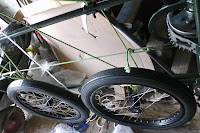We got the brakes before the wheels.
The machined parts were de-burred, not for mechanical necessity, but because I don't like being cut and scratched by sharp metal.
The disc calipers went on smoothly. The blank plugs on the calipers were done up tightly, as were the pad retaining pins, so these were loosened and put back in ( I used a spanner on the hex key to save wear and tear on arthritic joints.). Note from the pictures that I have not worked out what is UP and which way is DOWN. I have now put the hydraulic input in the down position, so that the bleed position will be upmost. It is also obvious from my pictures that I shall need to improve the paintwork.

The band brake/ hand brake required more assembly. Differential + metal band + lining = handbrake.
I pre-assembled the hand brake and noted that:
- the metal band needed to be bent slightly to allow for the bolts on the activation lever to move without scraping the differential braking surface.
- the three mounting screws for the band needed to be tightened so that the band allowed a gap for the drive chain all around.
- I decided to use 8 M5 brass c/s screws, in pairs, to back up the glue. Like others, I prefer a belt and braces approach.
- I drilled tapping holes in the metal band, while in position, so that I would be confident of a good fit later. The tapped threads made assembly easier, clamping the lining to the band when the glue had been applied. This also enabled the use of the nuts to lock the assembled brass screws.
- rather than clamp the lining in place while the glue matured, I assembled the parts in their final position and tightened the brake to provide clamping force.
- I have discovered some useful rope knots: I needed a bowline for the brake activator ( I would rather have used a shackle than garden wire, but needs must). I also used a Trucker's Hitch to tighten the brake.


The final assembly showing expressed glue and brass screws with nuts.

The final picture shows the Trucker's Hitch and the front wheels, just delivered.
The tyres from Avon are for front wheels of a classic motor bike, rated for 112 mph and a load of over 200kg at 40 psi. I'm not sure I shall be attempting that sort of speed or load in my vehicle!
Next steps are to get a better coverage and finish on existing paintwork, check the assembly so far, and get on with the front wheels. For the wheels I shall adjust the steering for zero toe-in/out.






 ;
;























